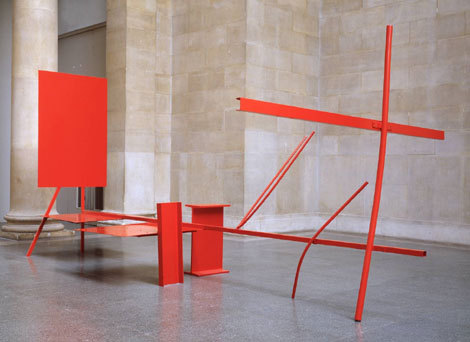Tate Britain’s retrospective of Anthony Caro’s sculpture begins, in the Duveen Sculpture Galleries, with a recent, monumental work by this youthful eighty-year-old artist, entitled Millbank Steps. Like much of Caro’s recent work, it exists on the borders of sculpture and architecture, consisting of four gigantic, interlinked, ziggurat-like shapes formed from sheets of steel that has rusted to a vivid orange – the colour, pretty much, of a very strong cup of tea. The forms are hollow, so that visitors can walk through and under and around the “steps” suggested by the sculptor’s title – to be sheltered in their recesses or daunted by their scale. Eventually the sculpture may be given a permanent home on the Embankment close to Parliament Square. It looks as if it was designed with that in mind. It would make a good meeting place and its ascending forms are perhaps intended to symbolise the ideal of aspiration (although a cynic, seeing it next to the Houses of Parliament, might be put in mind of the old adage about one step forward and two steps back).
There is also a whiff of primitivism in the air. Caro, once the revolutionary moderniser, the first British sculptor to abandon traditional carving and modelling for the oxyacetylene torch and the welding kit, has become eclectically enchanted by the civilisations of the distant past in his later years, making sculptures inspired by the writings of Homer and the pedimental temple carvings of Olympia, among other things. Perhaps Millbank Steps, with its faint echoes of ancient Mexican monuments, marks another stage in this back-to-front odyssey: from high-tec to Aztec, as it were. In addition, it suggests the depth of the artist’s fellow-feeling for the work of his slightly younger contemporary, the modern American sculptor Richard Serra, whose monolithic sheet-steel...

Anthony Caro at Tate Britain
30-01-2005

